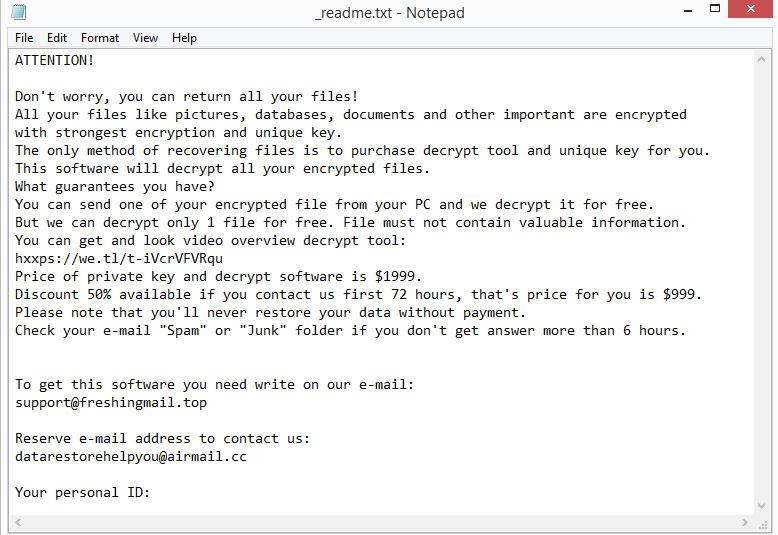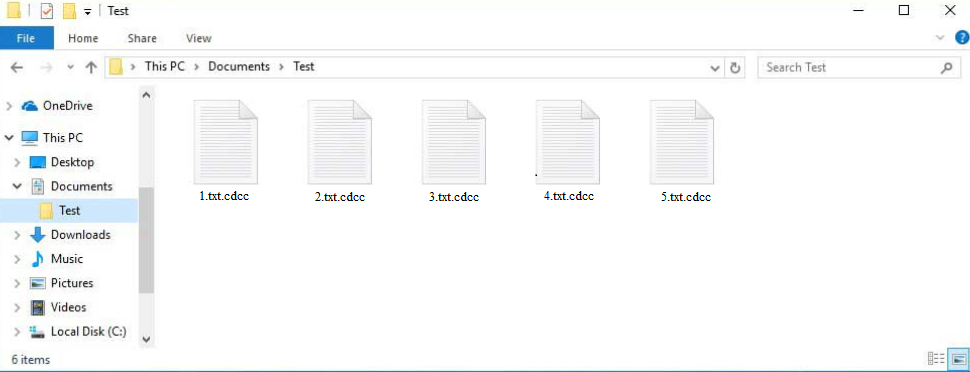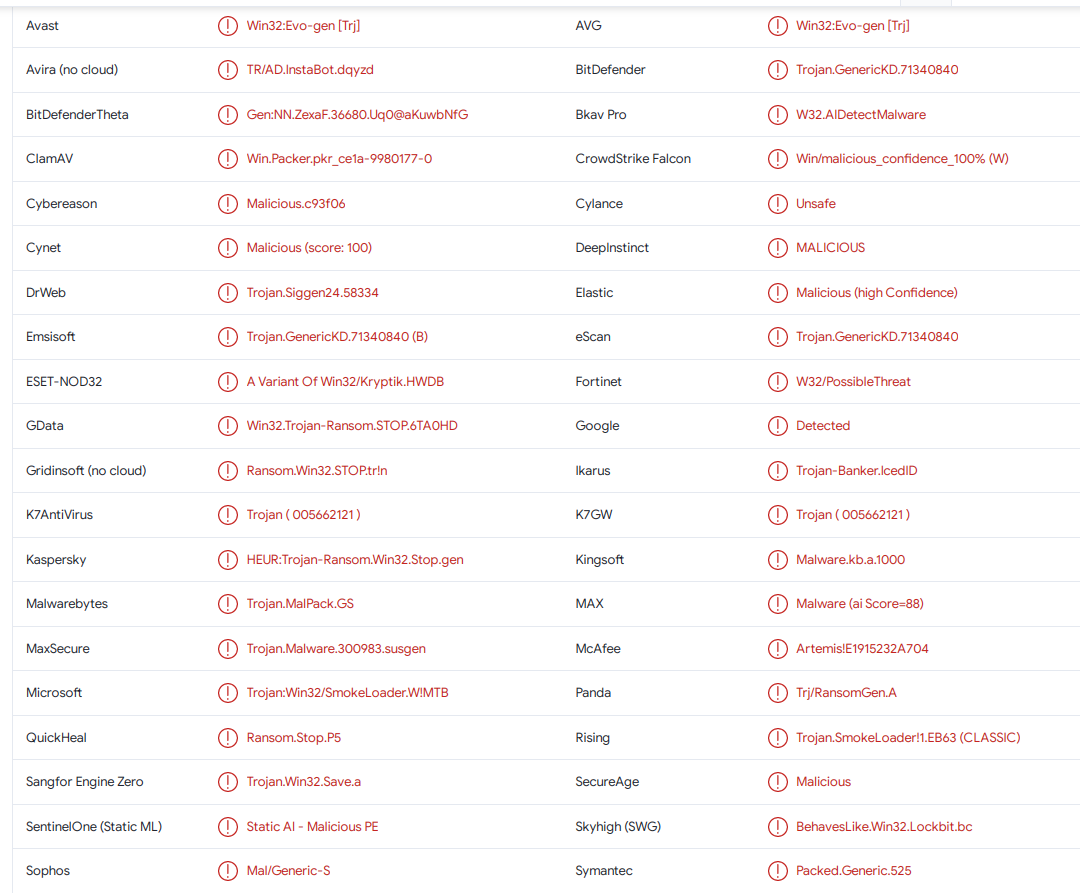Cdcc ransomware is file-encrypting malware from the Djvu/STOP ransomware family. It’s a dangerous piece of malware that essentially takes personal files hostage. Once files are encrypted, they will be very difficult to recover without a backup.
As soon as the ransomware is initiated, it will start encrypting files. It mainly targets personal files like documents, photos, videos, etc. While the ransomware encrypts files, it shows a fake Windows update window to distract users. Once it’s done, all encrypted files will have a .cdcc extension added to them. For example, an encrypted text.txt file would become text.txt.cdcc. You will not be able to open these files unless you first use a decryptor on them.
The ransomware drops a _readme.txt ransom note in all folders that have encrypted files. The note explains that files have been encrypted and that a decryptor is necessary to decrypt them. Unfortunately, that is mostly true. A decryptor is necessary to decrypt the files.
According to the note, to get the decryptor, users need to pay $1999 to the malware operators. Supposedly, there’s a 50% discount available for users who make contact within 72 hours.
ATTENTION!
Don’t worry, you can return all your files!
All your files like pictures, databases, documents and other important are encrypted
with strongest encryption and unique key.
The only method of recovering files is to purchase decrypt tool and unique key for you.
This software will decrypt all your encrypted files.
What guarantees you have?
You can send one of your encrypted file from your PC and we decrypt it for free.
But we can decrypt only 1 file for free. File must not contain valuable information.
You can get and look video overview decrypt tool:
hxxps://we.tl/t-iVcrVFVRqu
Price of private key and decrypt software is $1999.
Discount 50% available if you contact us first 72 hours, that’s price for you is $999.
Please note that you’ll never restore your data without payment.
Check your e-mail “Spam” or “Junk” folder if you don’t get answer more than 6 hours.To get this software you need write on our e-mail:
support@freshingmail.topReserve e-mail address to contact us:
datarestorehelpyou@airmail.ccYour personal ID:
When it comes to ransomware, paying the ransom is never recommended. Mainly because it does not guarantee that a decryptor will be sent. If you’re considering paying the ransom, you need to keep in mind that you are dealing with cybercriminals. There is nothing to force them to keep their end of the deal after you pay. Furthermore, if you pay, your money would be used to finance future criminal activities.
If you have a backup of your files, you can connect to it and start file recovery as soon as you remove Cdcc ransomware from your computer. To avoid additional damage, use an anti-malware program to delete Cdcc ransomware. Once the ransomware has been fully removed, you can safely connect to your backup.
For users with no backup, file recovery will be much more difficult, if not impossible. The only option is to wait for a free decryptor to become available. There currently is a free Djvu/STOP ransomware decryptor by Emsisoft but it will not work on newer Djvu versions because they use online keys to encrypt files, which means that all users have unique keys. Without those keys, a decryptor is unlikely.
If a decryptor does get released in the future, it would become available on NoMoreRansom. If you cannot find a decryptor on that site, it’s unlikely that you’ll find it anywhere else.
How did ransomware enter your computer?
Ransomware is distributed via email attachments, torrents, malicious ads and links, etc., Users who have bad browsing habits are much more likely to pick up malware because they engage in riskier activities. To avoid future malware infections, we strongly recommend becoming familiar with how malware is distributed and developing better browsing habits.
Ransomware is commonly spread via email attachments. Malicious actors launch malicious spam campaigns and target hundreds, if not thousands, of users with the same generic email that contains a malicious attachment. When users open the file, they initiate the malware on their devices.
Because these emails target a lot of users at the same time, they are very generic and quite easy to recognize as malicious. Senders claim to be from legitimate companies, supposedly sending a document that needs to be urgently reviewed. Commonly, malicious senders pretend to be from parcel delivery companies, government agencies, the tax office, etc. But what often gives these emails away is grammar/spelling mistakes. The mistakes are usually very glaring. You would never find such mistakes in legitimate emails sent by legitimate companies.
Another sign of a malicious email is a sender who should know your name using generic words like User, Member, Customer, etc., to address you. Usually, when senders email users with important business, they address users by name because it looks more professional but also personal. Malicious senders use generic words for several reasons. For one, they send the same email to hundreds of users. They also do not have access to users’ personal information besides the email address.
As a precaution, we always recommend scanning all unsolicited email attachments with anti-malware software or VirusTotal before opening them. These scans will ensure that you won’t open anything harmful to your computer.
Malware is also often found on poorly regulated torrent sites, particularly in torrents for popular movies, TV series, and video games. So using torrents to obtain copyrighted content is not only content theft but also dangerous for the computer.
Cdcc ransomware removal
Ransomware is a very complex infection. To avoid causing additional damage to your computer, it’s strongly recommended to use anti-malware software to remove Cdcc ransomware. If you try manual Cdcc ransomware removal and miss some ransomware components, the ransomware may be able to recover. And if you do not fully delete Cdcc ransomware but connect to your backup, your backed-up files will become encrypted as well.
Once you fully delete Cdcc ransomware from your computer, you can safely access your backup to start recovering your files. If you do not have a backup, your only option is to back up the encrypted files and wait for a free Cdcc ransomware decryptor to be released. Periodically check NoMoreRansom for a free Cdcc ransomware decryptor.
Cdcc ransomware is detected as:
- Win32:Evo-gen [Trj] by Avast/AVG
- A Variant Of Win32/Kryptik.HWDB by ESET
- HEUR:Trojan-Ransom.Win32.Stop.gen by Kaspersky
- Trojan.MalPack.GS by Malwarebytes
- Trojan:Win32/SmokeLoader.W!MTB by Microsoft
- Trojan.GenericKD.71340840 by BitDefender
- Artemis!E1915232A704 by McAfee
Offers
Download Removal Toolto scan for Cdcc ransomwareUse our recommended removal tool to scan for Cdcc ransomware. Trial version of provides detection of computer threats like Cdcc ransomware and assists in its removal for FREE. You can delete detected registry entries, files and processes yourself or purchase a full version.
More information about SpyWarrior and Uninstall Instructions. Please review SpyWarrior EULA and Privacy Policy. SpyWarrior scanner is free. If it detects a malware, purchase its full version to remove it.

WiperSoft Review Details WiperSoft (www.wipersoft.com) is a security tool that provides real-time security from potential threats. Nowadays, many users tend to download free software from the Intern ...
Download|more


Is MacKeeper a virus? MacKeeper is not a virus, nor is it a scam. While there are various opinions about the program on the Internet, a lot of the people who so notoriously hate the program have neve ...
Download|more


While the creators of MalwareBytes anti-malware have not been in this business for long time, they make up for it with their enthusiastic approach. Statistic from such websites like CNET shows that th ...
Download|more
Site Disclaimer
2-remove-virus.com is not sponsored, owned, affiliated, or linked to malware developers or distributors that are referenced in this article. The article does not promote or endorse any type of malware. We aim at providing useful information that will help computer users to detect and eliminate the unwanted malicious programs from their computers. This can be done manually by following the instructions presented in the article or automatically by implementing the suggested anti-malware tools.
The article is only meant to be used for educational purposes. If you follow the instructions given in the article, you agree to be contracted by the disclaimer. We do not guarantee that the artcile will present you with a solution that removes the malign threats completely. Malware changes constantly, which is why, in some cases, it may be difficult to clean the computer fully by using only the manual removal instructions.



